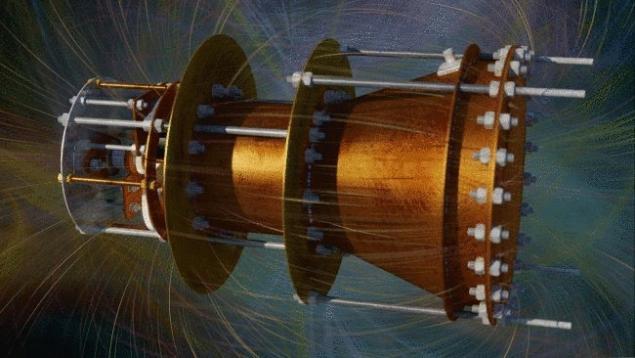618
NASA quietly test engine that violates the laws of physics

NASA successfully tests new space drive that uses no fuel and, in principle, should not work, at least in accordance with the laws of physics. We know little about him, and is not a new concept. The engine called Cannae Drive, performed well in direct tests of NASA, denying physics.
Cannae Drive is built on the works of Roger cholera, the British scientist who conceived of the so-called EMDrive. At the heart of his work is the running of microwaves in a closed chamber, which creates thrust. Scheuer never found someone who would be interested in the device despite the numerous demonstrations. His critics simply denied the device, indicating violation of the law of conservation of motion.
The Chinese are quietly experiencing their version of the EMDrive with 72 grams of thrust, enough to drive the satellite. About the structure just is not misleading, because few believe in the possibility of its existence.
Cannae Drive, apparently was developed independently from EMDrive, although works just the same. In the NASA tests demonstrated that the engine Cannae was able to create less than one thousandth the pull of the Chinese version. But the demonstration showed that it works.
NASA is a serious player in space science so when a team from the Agency had submitted that 'impossible' microwave engine works, this is very strange: either the results are wrong, or NASA has undertaken a major breakthrough in the field of space engines.
British scientist Roger Scheuer tried to interest people in his EMDrive for some years. According to his assurances, EmDrive converts electric power into thrust, requires no fuel, and all the work you do microwave in a closed container. He built a number of demonstration systems, but critics insisted: in accordance with the law of conservation of momentum, work they can't.
For good scientific practice, it was necessary that the third party repeated the results cholera. This happened: last year, the Chinese team of engineers has created its own EmDrive, which we mentioned. This engine could run on solar power, eliminating the need for fuel, which takes up to half the launch mass of many satellites. The Chinese work attracted little attention; it seems that no one in the West seriously believes in such a possibility.
Your own microwave engine built and American scientist Guido fetta, and he just managed to persuade NASA to test it. The results were positive.
The team from NASA's Johnson Space center called the work "anomalous thrust Production from an RF device, measured using nishtachaveh torsion pendulum". Five scientists spent six days creating the test equipment, and after two days experimenting with different configurations. The test incorporated a "zero movement" that is identical to the live version, but modified in such a way that the device produces the load that could have some effect that is not associated with the current device.
In the 90 years, NASA has experienced what could be called antigravity device based on spinning superconducting discs. The test results showed themselves very well, scientists do not understand that interference from devices affect the measuring instruments. It was a good lesson.
Twisting (torsion) of the scales they use to test the thrust was sensitive enough to detect a thrust of less than ten micronewtons, but the engine actually produced 30 to 50 micronewtons — less than one thousandth of the Chinese results, but defined positively, despite the law of conservation of momentum.

"Test results show that the project of radio frequency engine with a resonant cavity of a unique device for electricity, produces a force which cannot be attributed to any known classical electromagnetic phenomena, and, therefore, can demonstrate the interaction with the quantum vacuum virtual plasma".
The last line means that the engine can run, thrusting the ghostly cloud of particles and antiparticles that are constantly popping up into the light and disappearing again in empty space. But the NASA team is trying to avoid explanation of their results, just reporting what you've found.
Engine inventor, Guido fetta, called it the Cannae Drive (the"Cannes engine"), referring to the battle of cannae, in which Hannibal defeated a stronger Roman army: you fight well, caught in a difficult situation. However, as Scheuer, fetta have spent years trying to persuade sceptics simply to look at it. Looks like he came to success.
"From what I understand of the NASA and Cannae work -- their RF engine actually works similar to EmDrive, except that the asymmetric force derives from a reduced reflection coefficient at one end of the Board," says Scheuer. He believes that this reduces the specific thrust of the engine.
Fett is working on several projects that can not yet discuss, but the PR team of NASA was unable to obtain comments from a group of scientists. However, it is fair to assume that these results were obtained rather quickly, as in the case of anomalous neutrinos faster than the speed of light. The issue with the neutrino cleared fairly quickly, but given that this is the third case of setting up an independent engine without fuel, which runs in tests, abnormal cravings can be much harder to explain than it seems.
Operation of a microwave engine could seriously reduce the cost of satellites and space stations and extend their working life, to provide thrust mission in deep space and to deliver astronauts to Mars in weeks rather than months. This may be one of the greatest inventions in the UK.
However, from the explanations of NASA, we can assume that the space Agency is also not fully sure. The question is: can I scale this engine and used for space travel? Possible. But we need more research. published
Source: hi-news.ru
How to properly care for a dog or cat: experts ' recommendations
The cultivation of cabbage seedlings























